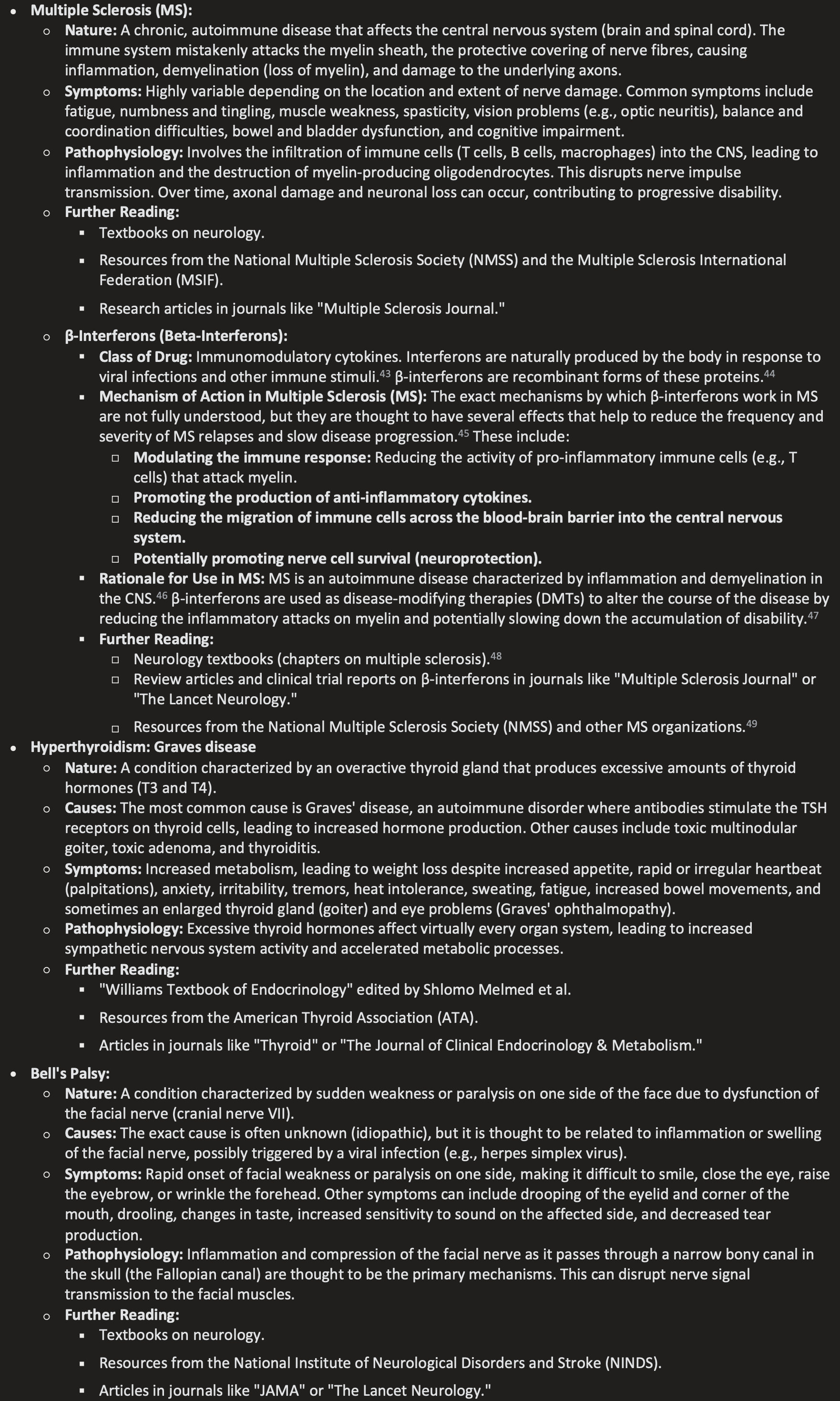Untitled Flashcards Set
Multiple Sclerosis (MS):
Nature: A chronic, autoimmune disease that affects the central nervous system (brain and spinal cord). The immune system mistakenly attacks the myelin sheath, the protective covering of nerve fibres, causing inflammation, demyelination (loss of myelin), and damage to the underlying axons.
Symptoms: Highly variable depending on the location and extent of nerve damage. Common symptoms include fatigue, numbness and tingling, muscle weakness, spasticity, vision problems (e.g., optic neuritis), balance and coordination difficulties, bowel and bladder dysfunction, and cognitive impairment.
Pathophysiology: Involves the infiltration of immune cells (T cells, B cells, macrophages) into the CNS, leading to inflammation and the destruction of myelin-producing oligodendrocytes. This disrupts nerve impulse transmission. Over time, axonal damage and neuronal loss can occur, contributing to progressive disability.
Further Reading:
Textbooks on neurology.
Resources from the National Multiple Sclerosis Society (NMSS) and the Multiple Sclerosis International Federation (MSIF).
Research articles in journals like "Multiple Sclerosis Journal."
β-Interferons (Beta-Interferons):
Class of Drug: Immunomodulatory cytokines. Interferons are naturally produced by the body in response to viral infections and other immune stimuli.43 β-interferons are recombinant forms of these proteins.44
Mechanism of Action in Multiple Sclerosis (MS): The exact mechanisms by which β-interferons work in MS are not fully understood, but they are thought to have several effects that help to reduce the frequency and severity of MS relapses and slow disease progression.45 These include:
Modulating the immune response: Reducing the activity of pro-inflammatory immune cells (e.g., T cells) that attack myelin.
Promoting the production of anti-inflammatory cytokines.
Reducing the migration of immune cells across the blood-brain barrier into the central nervous system.
Potentially promoting nerve cell survival (neuroprotection).
Rationale for Use in MS: MS is an autoimmune disease characterized by inflammation and demyelination in the CNS.46 β-interferons are used as disease-modifying therapies (DMTs) to alter the course of the disease by reducing the inflammatory attacks on myelin and potentially slowing down the accumulation of disability.47
Further Reading:
Neurology textbooks (chapters on multiple sclerosis).48
Review articles and clinical trial reports on β-interferons in journals like "Multiple Sclerosis Journal" or "The Lancet Neurology."
Resources from the National Multiple Sclerosis Society (NMSS) and other MS organizations.49
Hyperthyroidism: Graves disease
Nature: A condition characterized by an overactive thyroid gland that produces excessive amounts of thyroid hormones (T3 and T4).
Causes: The most common cause is Graves' disease, an autoimmune disorder where antibodies stimulate the TSH receptors on thyroid cells, leading to increased hormone production. Other causes include toxic multinodular goiter, toxic adenoma, and thyroiditis.
Symptoms: Increased metabolism, leading to weight loss despite increased appetite, rapid or irregular heartbeat (palpitations), anxiety, irritability, tremors, heat intolerance, sweating, fatigue, increased bowel movements, and sometimes an enlarged thyroid gland (goiter) and eye problems (Graves' ophthalmopathy).
Pathophysiology: Excessive thyroid hormones affect virtually every organ system, leading to increased sympathetic nervous system activity and accelerated metabolic processes.
Further Reading:
"Williams Textbook of Endocrinology" edited by Shlomo Melmed et al.
Resources from the American Thyroid Association (ATA).
Articles in journals like "Thyroid" or "The Journal of Clinical Endocrinology & Metabolism."
Bell's Palsy:
Nature: A condition characterized by sudden weakness or paralysis on one side of the face due to dysfunction of the facial nerve (cranial nerve VII).
Causes: The exact cause is often unknown (idiopathic), but it is thought to be related to inflammation or swelling of the facial nerve, possibly triggered by a viral infection (e.g., herpes simplex virus).
Symptoms: Rapid onset of facial weakness or paralysis on one side, making it difficult to smile, close the eye, raise the eyebrow, or wrinkle the forehead. Other symptoms can include drooping of the eyelid and corner of the mouth, drooling, changes in taste, increased sensitivity to sound on the affected side, and decreased tear production.
Pathophysiology: Inflammation and compression of the facial nerve as it passes through a narrow bony canal in the skull (the Fallopian canal) are thought to be the primary mechanisms. This can disrupt nerve signal transmission to the facial muscles.
Further Reading:
Textbooks on neurology.
Resources from the National Institute of Neurological Disorders and Stroke (NINDS).
Articles in journals like "JAMA" or "The Lancet Neurology."
